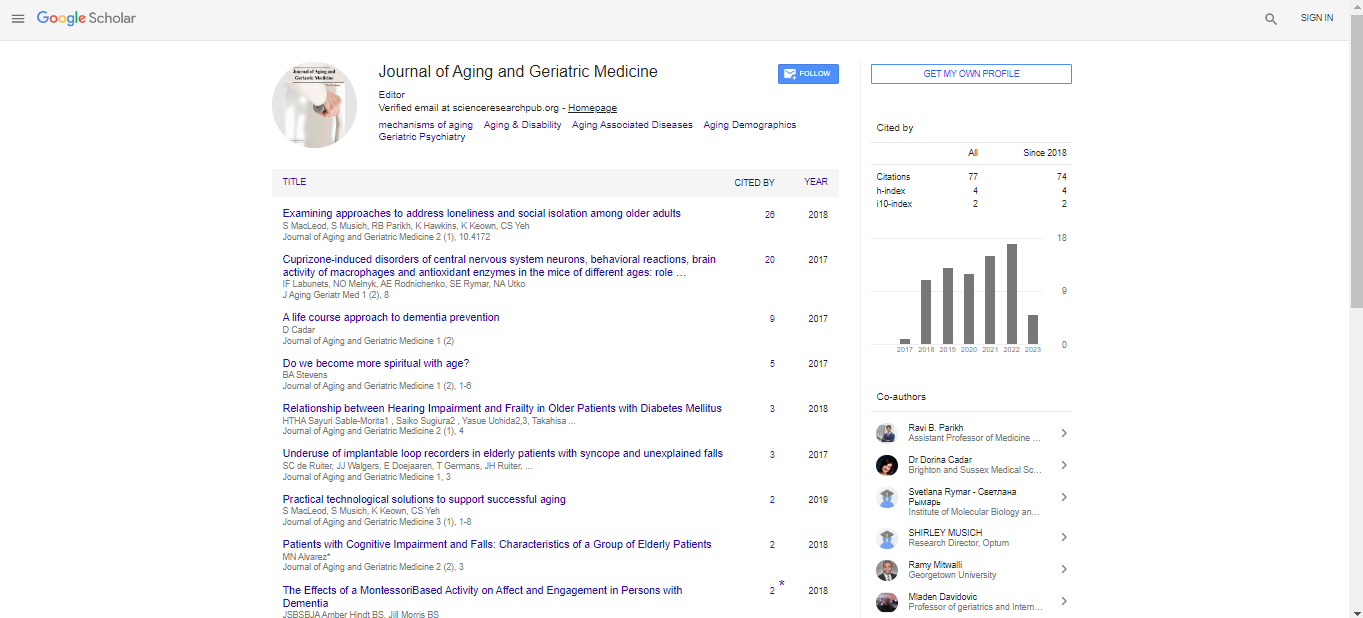Editorial, J Aging Geriatr Med Vol: 8 Issue: 1
Polypharmacy: A Growing Concern in Modern Healthcare
Glory Fury*
Department of Health Sciences, University of Naples Federico II, Italy
- *Corresponding Author:
- Glory Fury
Department of Health Sciences, University of Naples Federico II, Italy
E-mail: fury529@gmail.com
Received: 01-Jan-2025, Manuscript No. agm-25-169744; Editor assigned: 4-Jan-2025, Pre-QC No. agm-25-169744 (PQ); Reviewed: 18-Jan-2025, QC No. agm-25-169744; Revised: 25-Jan-2025, Manuscript No. agm-25-169744 (R); Published: 30-Jan-2025, DOI: 10.4172/2576-3946.1000178
Citation: Glory F (2025) Polypharmacy: A Growing Concern in Modern Healthcare. J Aging Geriatr Med 8:178
Introduction
In today’s complex healthcare environment, the term polypharmacy has become increasingly relevant, especially among older adults and those with multiple chronic conditions. Polypharmacy refers to the concurrent use of multiple medications by a patient, typically defined as the use of five or more drugs at once. While in some cases polypharmacy is clinically appropriate, it often raises concerns about safety, efficacy, and quality of life. Mismanagement of multiple medications can lead to adverse drug reactions, drug interactions, increased healthcare costs, and decreased patient adherence [1].
Polypharmacy is a growing concern in modern healthcare, particularly among older adults and individuals with multiple chronic conditions. Defined as the use of five or more medications simultaneously, polypharmacy can be appropriate when each drug is necessary and beneficial. However, it often becomes problematic when medications are prescribed without clear indication, continued unnecessarily, or interact harmfully with one another [2].
As life expectancy increases and chronic diseases like diabetes, hypertension, arthritis, and heart disease become more prevalent, the number of prescribed medications per patient tends to rise. While this reflects advances in medical treatment, it also increases the complexity of care and the risk of adverse effects. Polypharmacy is particularly common among the elderly, who may see multiple healthcare providers, each prescribing medications that may not be fully coordinated [3], [4].
The potential risks of polypharmacy include adverse drug reactions, harmful drug interactions, medication non-adherence, cognitive decline, falls, hospitalizations, and even death. These outcomes not only affect patient safety and quality of life but also place a significant financial burden on healthcare systems.
Despite its risks, polypharmacy is not always inappropriate. In many cases, multiple medications are essential for managing complex health conditions. The key challenge lies in identifying when polypharmacy becomes harmful and taking steps to optimize medication use. Regular medication reviews, improved communication between healthcare providers, pharmacist involvement, and patient education are essential tools in managing this issue effectively [5].
As healthcare continues to evolve, recognizing and addressing polypharmacy is critical to ensuring safe, effective, and patient-centered care. With thoughtful prescribing and a collaborative approach, it is possible to reduce medication-related harm while maintaining the therapeutic benefits that medications can provide.
Discussion
Polypharmacy refers to the concurrent use of multiple medications by a patient, commonly defined as the regular use of five or more drugs. It is especially prevalent among older adults who often have multiple chronic conditions requiring complex treatment regimens. While the use of multiple medications may be necessary to manage coexisting diseases, polypharmacy increases the risk of adverse drug reactions, drug interactions, medication non-adherence, and hospitalizations.
One of the major challenges with polypharmacy is balancing the benefits and risks of each medication. Older adults experience physiological changes—such as decreased renal and hepatic function—that affect drug metabolism and clearance, increasing their susceptibility to side effects. Additionally, the risk of prescribing potentially inappropriate medications rises with the number of drugs, leading to issues such as falls, cognitive impairment, and bleeding complications.
Polypharmacy also complicates medication management. Patients may have difficulty understanding or adhering to complex regimens, especially when multiple prescribers are involved. This can lead to medication errors, duplication, or omissions. Furthermore, the financial burden of multiple medications can impact adherence and quality of life.
Addressing polypharmacy requires a comprehensive, patient-centered approach. Regular medication reviews, ideally by a multidisciplinary team including physicians, pharmacists, and nurses, help identify unnecessary or harmful medications. Deprescribing—systematically reducing or stopping medications that are no longer needed or potentially harmful—is an essential strategy to minimize polypharmacy-related risks.
In conclusion, while polypharmacy is often unavoidable in managing multiple chronic illnesses, careful oversight is crucial to optimize treatment benefits and reduce harm. Improved communication among healthcare providers, patient education, and individualized care plans are vital to safely manage polypharmacy and enhance outcomes, particularly in vulnerable elderly populations.
Conclusion
Polypharmacy is a growing challenge in modern medicine, particularly as populations age and the prevalence of chronic diseases increases. While multiple medications are sometimes necessary for optimal care, their use must be balanced with caution and regular evaluation. Unchecked polypharmacy can lead to adverse outcomes, decreased quality of life, and increased healthcare costs. Addressing this issue requires collaboration among healthcare providers, patients, caregivers, and systems. Through medication reviews, education, and the use of technology, it is possible to minimize risks and ensure that patients receive the most appropriate and effective therapies. By focusing on individualized care and ongoing assessment, healthcare professionals can turn polypharmacy from a problem into an opportunity for better, safer care.
References
- Colletti JE, Kothari, S, Kothori S, Jackson DM, Kilgore KP, et al. (2007) "An emergency medicine approach to neonatal hyperbilirubinemia". Emerg Med Clin North Am 25: 1117-35, vii.
- Watchko JF (2006) "Hyperbilirubinemia and bilirubin toxicity in the late preterm infant". Clin Perinatol 33: 839-582.
- Shah Z, Chawla A, Patkar D, Pungaonkar S (2003) "MRI in kernicterus". Australas Radiol 47: 55-57.
- Gómez M, Bielza C, Pozo FD, Rios Insua S (2007) "A graphical decision-theoretic model for neonatal jaundice". Med Decis Making 27: 250-265.
- Gilmour, Susan M (2004) "Prolonged neonatal jaundice: When to worry and what to do". Paediatr Child Health 9: 700-704.
Indexed at, Google Scholar, Crossref
Indexed at, Google Scholar, Crossref
Indexed at, Google Scholar, Crossref
Indexed at, Google Scholar, Crossref
 Spanish
Spanish  Chinese
Chinese  Russian
Russian  German
German  French
French  Japanese
Japanese  Portuguese
Portuguese  Hindi
Hindi 